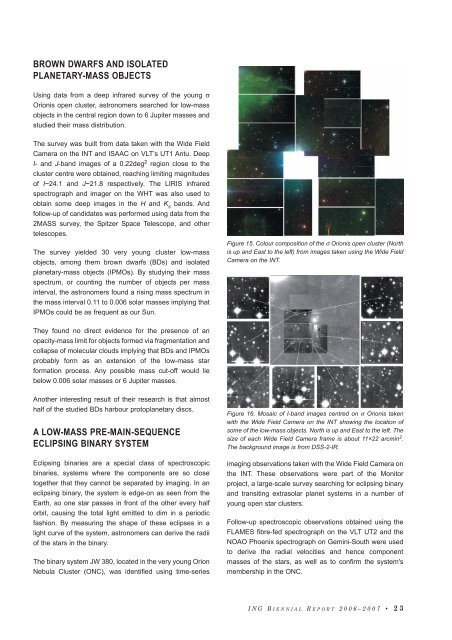PDF (6M) - Isaac Newton Group of Telescopes - Instituto de ...
PDF (6M) - Isaac Newton Group of Telescopes - Instituto de ...
PDF (6M) - Isaac Newton Group of Telescopes - Instituto de ...
You also want an ePaper? Increase the reach of your titles
YUMPU automatically turns print PDFs into web optimized ePapers that Google loves.
BROWN DWARFS AND ISOLATED<br />
PLANETARY-MASS OBJECTS<br />
Using data from a <strong>de</strong>ep infrared survey <strong>of</strong> the young σ<br />
Orionis open cluster, astronomers searched for low-mass<br />
objects in the central region down to 6 Jupiter masses and<br />
studied their mass distribution.<br />
The survey was built from data taken with the Wi<strong>de</strong> Field<br />
Camera on the INT and ISAAC on VLT’s UT1 Antu. Deep<br />
I- and J-band images <strong>of</strong> a 0.22<strong>de</strong>g 2 region close to the<br />
cluster centre were obtained, reaching limiting magnitu<strong>de</strong>s<br />
<strong>of</strong> I~24.1 and J~21.8 respectively. The LIRIS infrared<br />
spectrograph and imager on the WHT was also used to<br />
obtain some <strong>de</strong>ep images in the H and K s<br />
bands. And<br />
follow-up <strong>of</strong> candidates was performed using data from the<br />
2MASS survey, the Spitzer Space Telescope, and other<br />
telescopes.<br />
The survey yiel<strong>de</strong>d 30 very young cluster low-mass<br />
objects, among them brown dwarfs (BDs) and isolated<br />
planetary-mass objects (IPMOs). By studying their mass<br />
spectrum, or counting the number <strong>of</strong> objects per mass<br />
interval, the astronomers found a rising mass spectrum in<br />
the mass interval 0.11 to 0.006 solar masses implying that<br />
IPMOs could be as frequent as our Sun.<br />
Figure 15. Colour composition <strong>of</strong> the σ Orionis open cluster (North<br />
is up and East to the left) from images taken using the Wi<strong>de</strong> Field<br />
Camera on the INT.<br />
They found no direct evi<strong>de</strong>nce for the presence <strong>of</strong> an<br />
opacity-mass limit for objects formed via fragmentation and<br />
collapse <strong>of</strong> molecular clouds implying that BDs and IPMOs<br />
probably form as an extension <strong>of</strong> the low-mass star<br />
formation process. Any possible mass cut-<strong>of</strong>f would lie<br />
below 0.006 solar masses or 6 Jupiter masses.<br />
Another interesting result <strong>of</strong> their research is that almost<br />
half <strong>of</strong> the studied BDs harbour protoplanetary discs.<br />
A LOW-MASS PRE-MAIN-SEQUENCE<br />
ECLIPSING BINARY SYSTEM<br />
Eclipsing binaries are a special class <strong>of</strong> spectroscopic<br />
binaries, systems where the components are so close<br />
together that they cannot be separated by imaging. In an<br />
eclipsing binary, the system is edge-on as seen from the<br />
Earth, so one star passes in front <strong>of</strong> the other every half<br />
orbit, causing the total light emitted to dim in a periodic<br />
fashion. By measuring the shape <strong>of</strong> these eclipses in a<br />
light curve <strong>of</strong> the system, astronomers can <strong>de</strong>rive the radii<br />
<strong>of</strong> the stars in the binary.<br />
The binary system JW 380, located in the very young Orion<br />
Nebula Cluster (ONC), was i<strong>de</strong>ntified using time-series<br />
Figure 16. Mosaic <strong>of</strong> I-band images centred on σ Orionis taken<br />
with the Wi<strong>de</strong> Field Camera on the INT showing the location <strong>of</strong><br />
some <strong>of</strong> the low-mass objects. North is up and East to the left. The<br />
size <strong>of</strong> each Wi<strong>de</strong> Field Camera frame is about 11×22 arcmin 2 .<br />
The background image is from DSS-2-IR.<br />
imaging observations taken with the Wi<strong>de</strong> Field Camera on<br />
the INT. These observations were part <strong>of</strong> the Monitor<br />
project, a large-scale survey searching for eclipsing binary<br />
and transiting extrasolar planet systems in a number <strong>of</strong><br />
young open star clusters.<br />
Follow-up spectroscopic observations obtained using the<br />
FLAMES fibre-fed spectrograph on the VLT UT2 and the<br />
NOAO Phoenix spectrograph on Gemini-South were used<br />
to <strong>de</strong>rive the radial velocities and hence component<br />
masses <strong>of</strong> the stars, as well as to confirm the system's<br />
membership in the ONC.<br />
ING BIENNIAL R EPORT 2006–2007 • 23
















